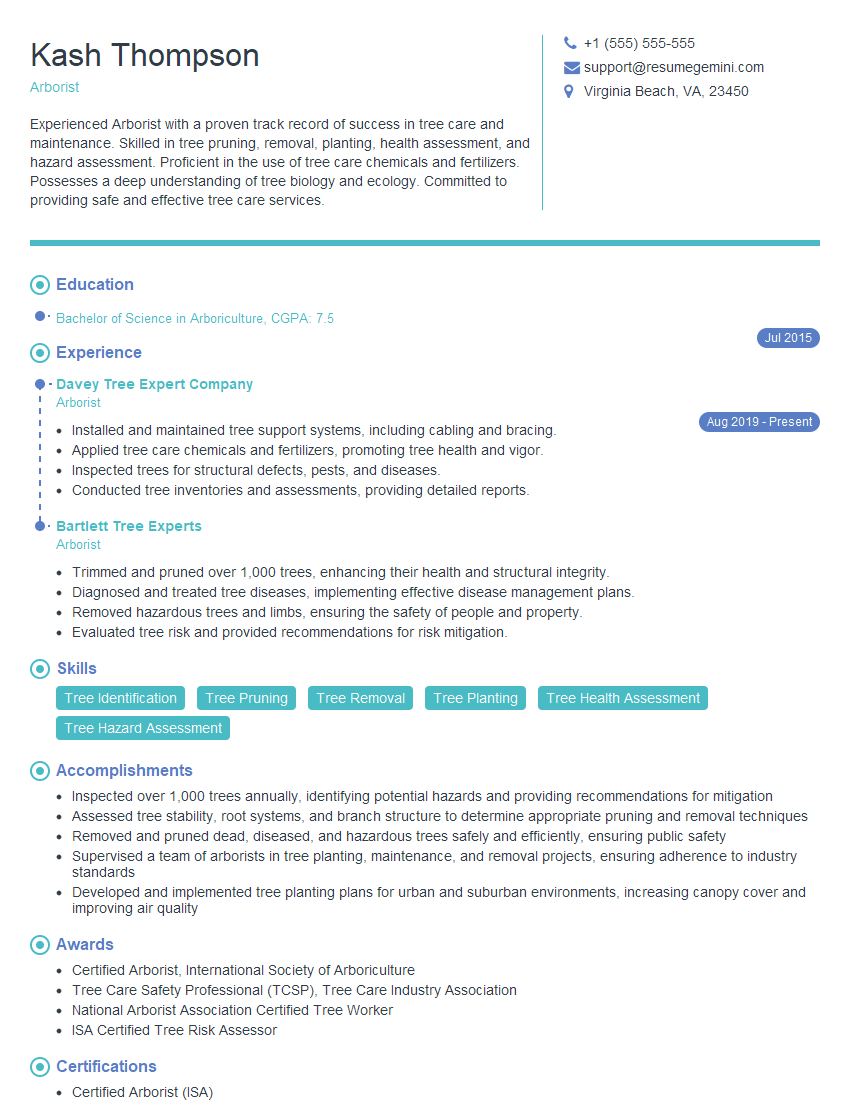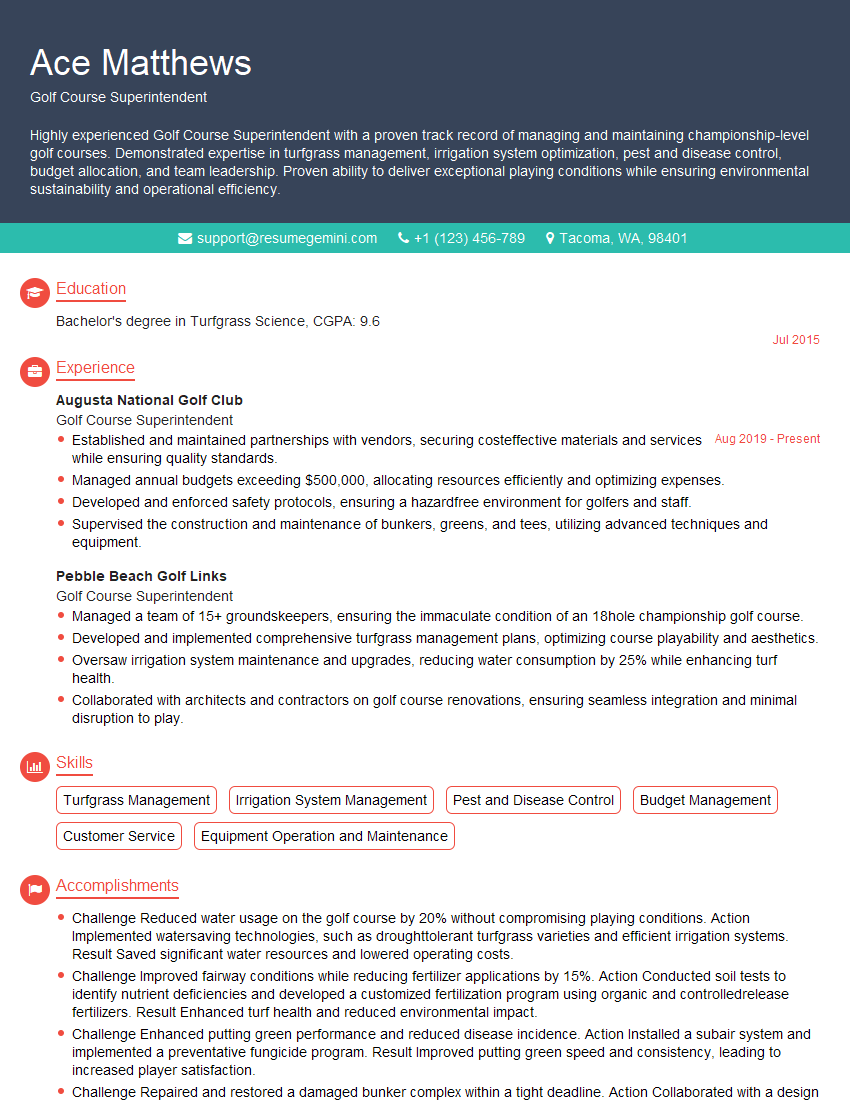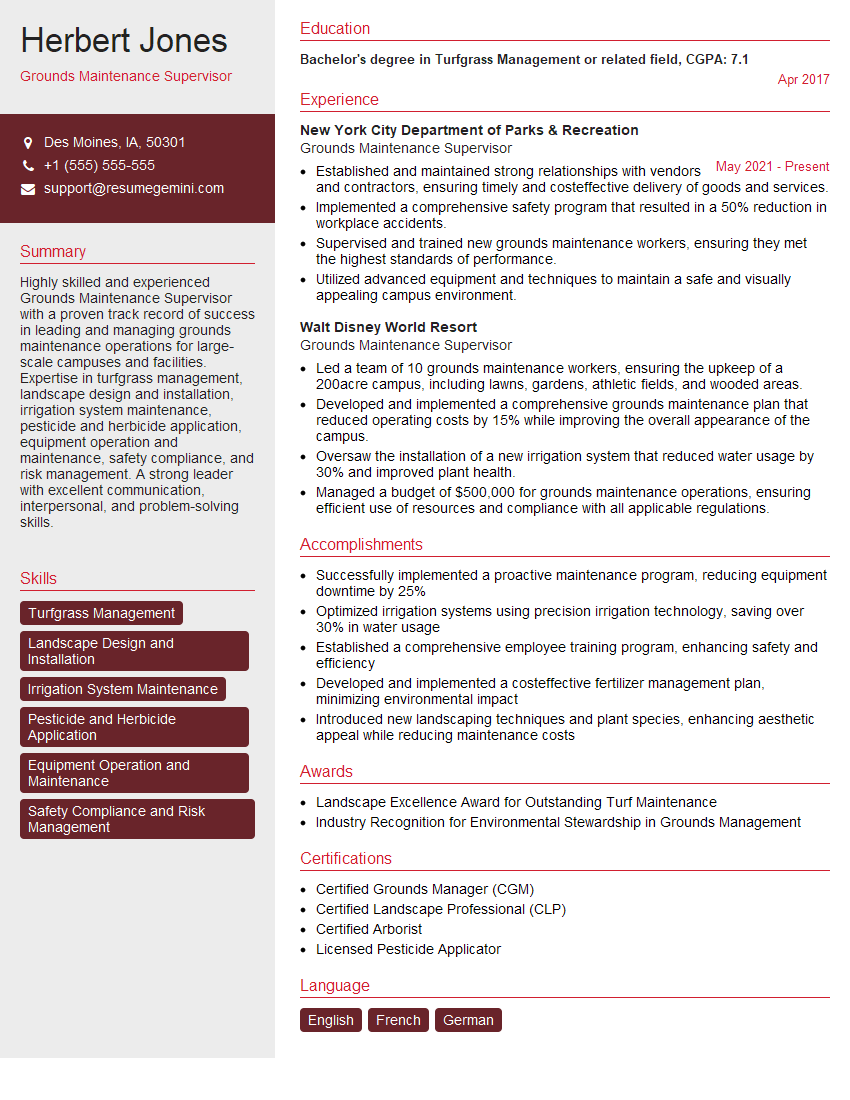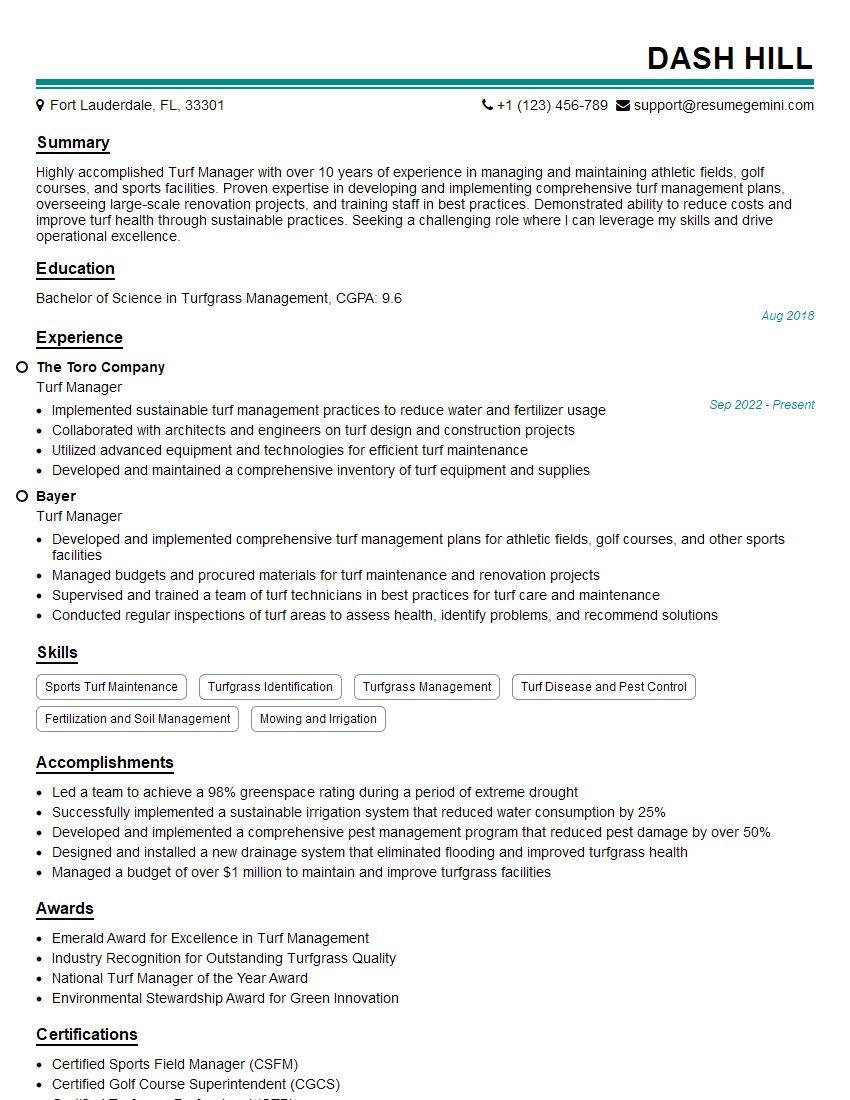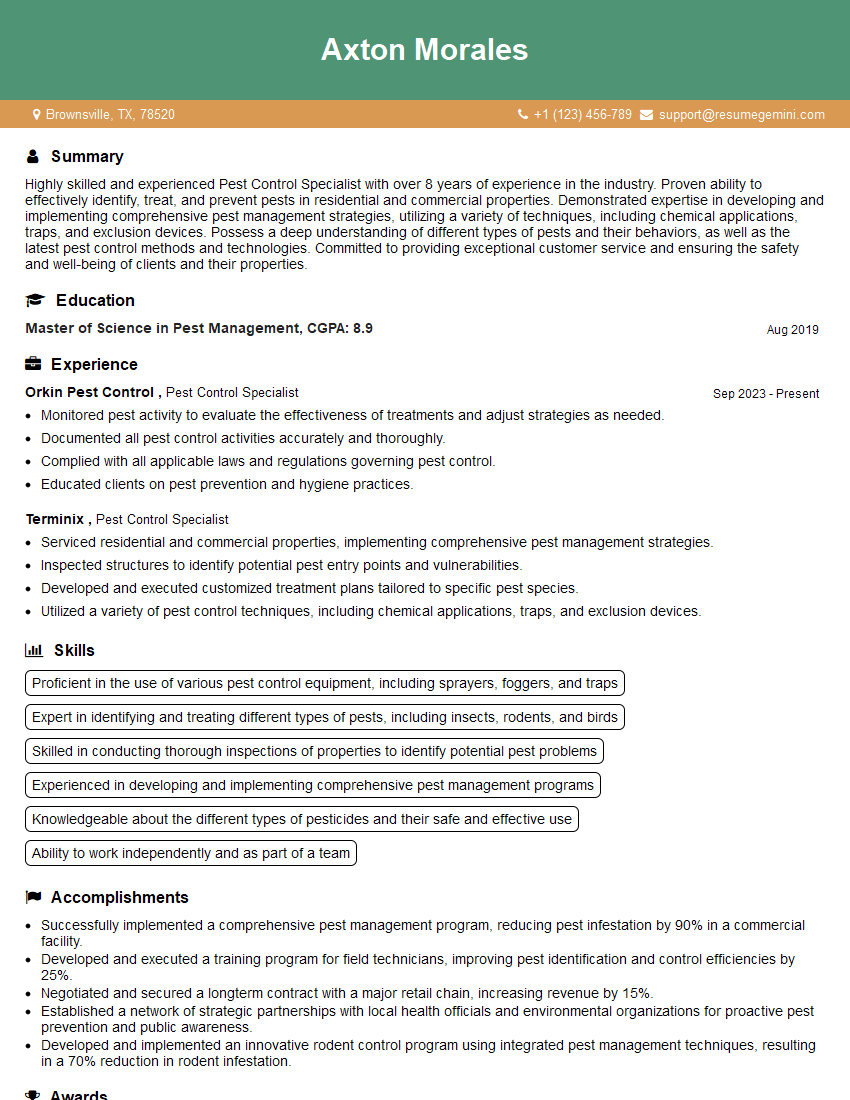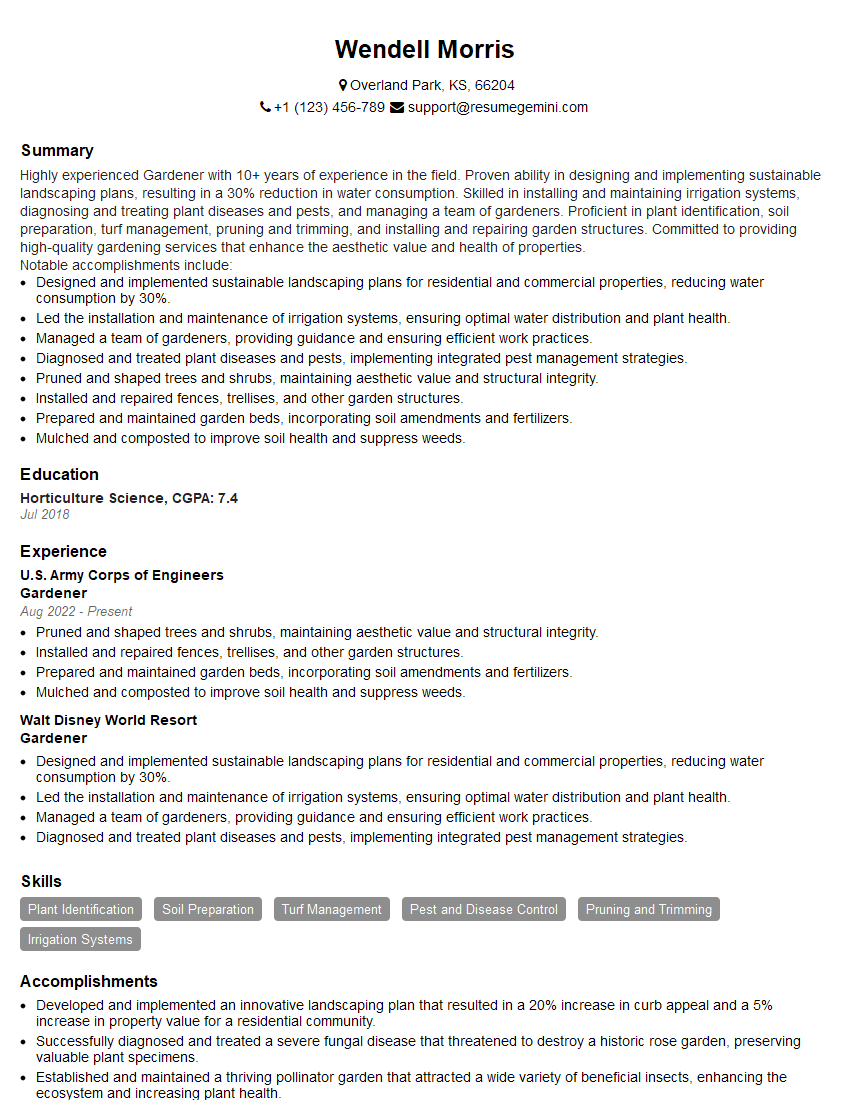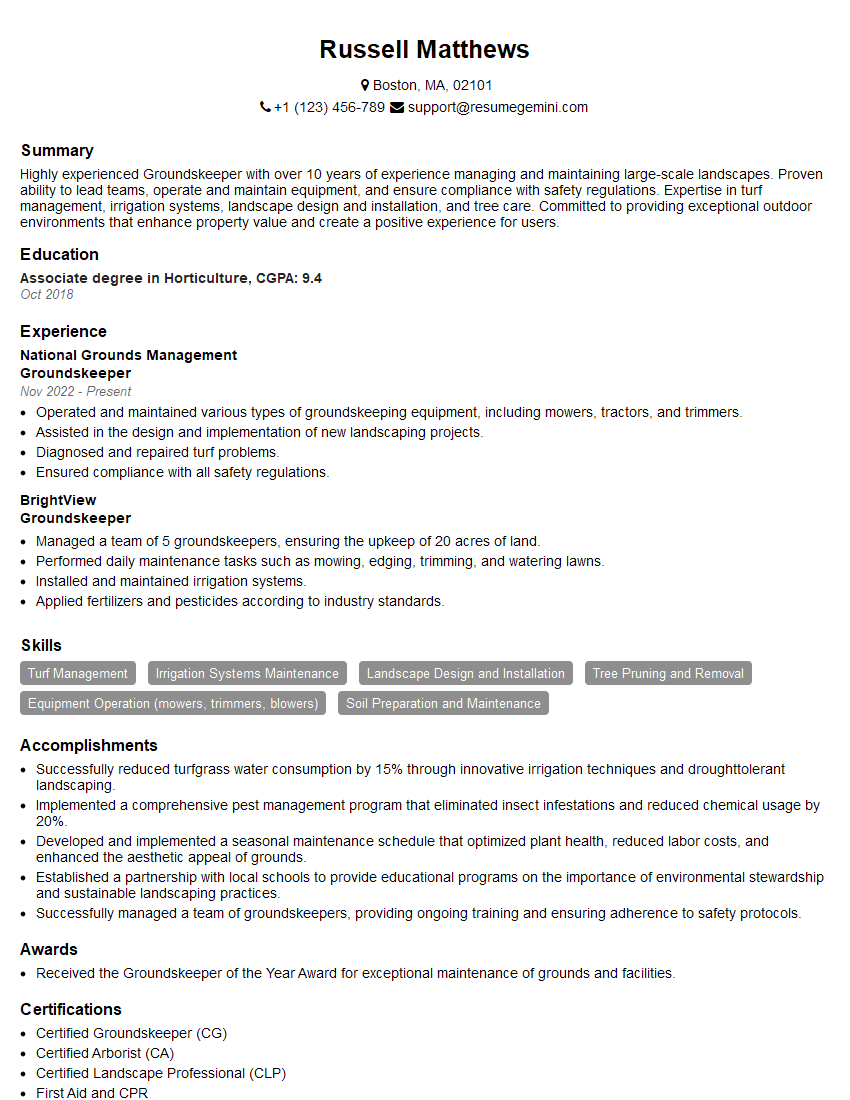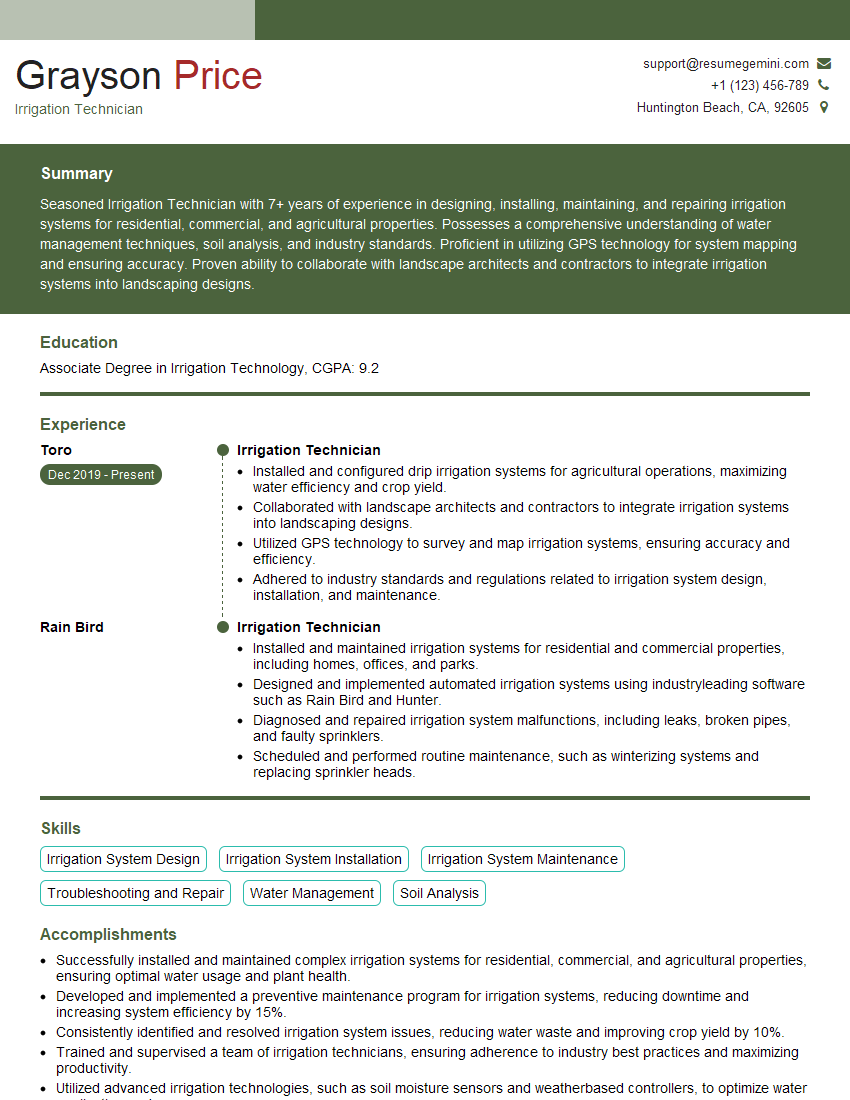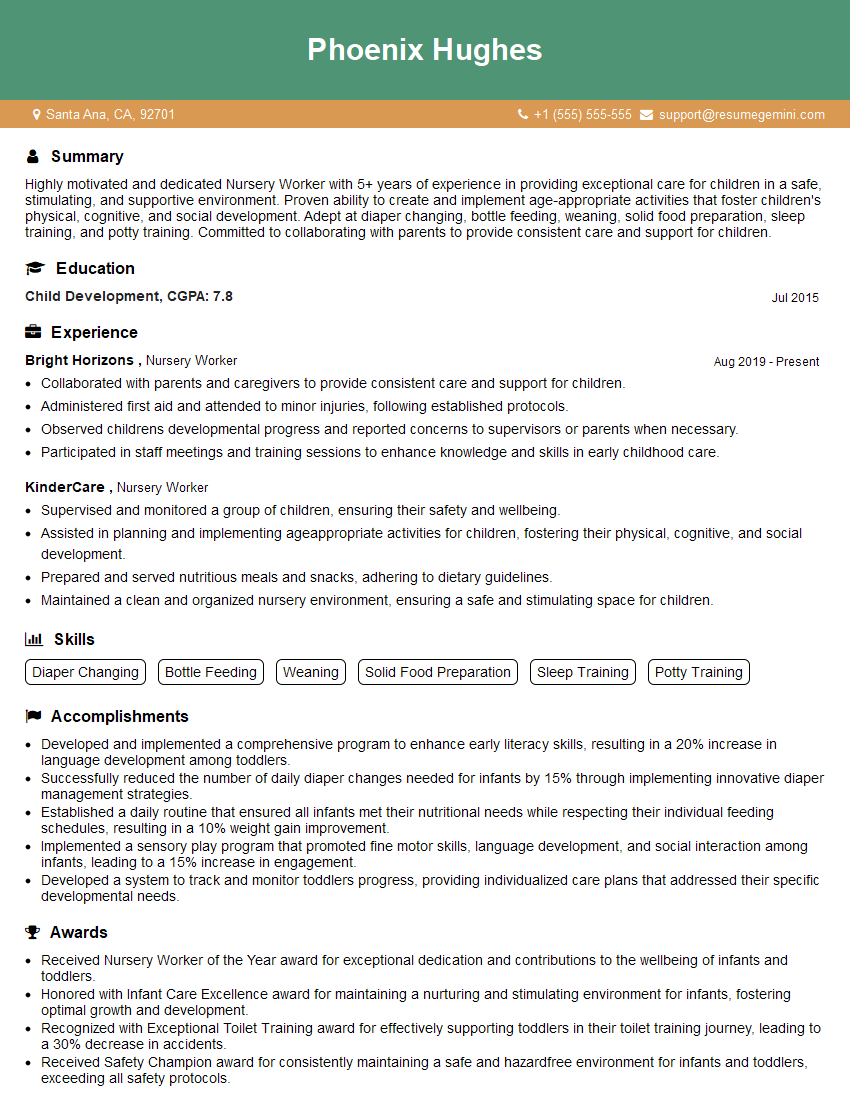Interviews are more than just a Q&A session—they’re a chance to prove your worth. This blog dives into essential Groundskeeping Techniques interview questions and expert tips to help you align your answers with what hiring managers are looking for. Start preparing to shine!
Questions Asked in Groundskeeping Techniques Interview
Q 1. Describe your experience with various turfgrass types and their maintenance requirements.
My experience encompasses a wide range of turfgrass types, each demanding a unique maintenance approach. For instance, cool-season grasses like Kentucky bluegrass thrive in cooler climates and require regular fertilization in spring and fall. Their maintenance involves frequent mowing at a higher height in the summer to prevent heat stress and adjusting mowing heights throughout the growing season. Conversely, warm-season grasses like Bermuda grass prefer hot, sunny conditions and need less frequent mowing but are more susceptible to drought. Their maintenance involves deeper watering less frequently to encourage deeper root growth and resistance to heat stress. I’m also experienced with Zoysia grass, known for its fine texture and low maintenance needs, and Fescue, a drought-tolerant option often used in blended turf mixes. Understanding the specific needs of each grass type – from mowing height and frequency to fertilization schedules and watering – is crucial for achieving a healthy, vibrant lawn.
- Kentucky Bluegrass: Regular fertilization, frequent mowing at higher heights in summer.
- Bermuda Grass: Less frequent mowing, deep infrequent watering.
- Zoysia Grass: Low maintenance, drought-tolerant.
- Fescue: Drought-tolerant, often used in blends.
Q 2. Explain your knowledge of irrigation systems, including installation, maintenance, and troubleshooting.
My expertise in irrigation systems extends from initial design and installation to ongoing maintenance and troubleshooting. I’m proficient in various irrigation technologies, including drip irrigation, sprinkler systems (rotor and spray), and subsurface irrigation. During installation, careful site analysis is paramount to ensure even water distribution and minimize water waste. This involves considering soil type, slope, and sunlight exposure. Regular maintenance includes inspecting for leaks, cleaning nozzles, and checking pressure regulators. Troubleshooting involves identifying the source of problems, such as clogged emitters or malfunctioning valves. For example, if a section of the lawn isn’t getting watered properly, I would systematically check the sprinkler heads in that area for clogs or damage, then move to the valves and finally to the main water supply line. Data logging and water-efficient irrigation scheduling are crucial components of modern irrigation management, optimizing water usage while ensuring lawn health. I also have experience with smart irrigation controllers which use weather data to adjust watering schedules automatically, further improving efficiency and reducing water waste.
Q 3. What are your preferred methods for pest and disease control in landscaping?
My approach to pest and disease control emphasizes Integrated Pest Management (IPM), a sustainable strategy that prioritizes prevention and minimizes the use of pesticides. This involves regular monitoring for signs of pests and diseases, identifying the specific problem, and implementing the least toxic control measure. Cultural practices, such as proper fertilization and watering, play a vital role in preventing problems before they arise. I’ll use beneficial insects or nematodes where appropriate and only resort to chemical control as a last resort and always select the least toxic option, following label instructions precisely. For example, instead of immediately spraying for aphids, I might first try introducing ladybugs, a natural predator. Documentation of all pest and disease issues and the treatment plans followed is crucial for tracking trends and maintaining detailed records.
Q 4. How do you prioritize tasks in a busy groundskeeping schedule?
Prioritizing tasks in a busy groundskeeping schedule requires a systematic approach. I typically use a combination of methods, including:
- Urgency and Importance Matrix: Categorizing tasks based on their urgency and importance (high urgency/high importance, high urgency/low importance, etc.). This helps me focus on the most critical tasks first.
- Seasonal Planning: Creating a seasonal schedule that anticipates the needs of the landscape throughout the year. This allows for proactive planning and efficient resource allocation.
- Regular Inspections and Assessments: Regularly inspecting the grounds to identify issues and prioritize repairs or maintenance.
- Teamwork and Communication: Effective communication within the team to ensure all tasks are assigned and completed efficiently. Delegating when appropriate also helps free up my time for tasks that require my specific expertise.
For instance, during the spring, my priority might shift to fertilization and lawn aeration, while in the fall, leaf cleanup and overseeding might take precedence. This flexibility and planned approach ensures that tasks are always completed efficiently and effectively.
Q 5. Describe your experience with different fertilization techniques and their impact on plant health.
My experience with fertilization techniques includes various methods, each impacting plant health differently. Soil testing is the foundation of any effective fertilization program, determining the specific nutrient needs of the plants. Based on these results, I determine the appropriate type and amount of fertilizer, applying it using methods such as broadcasting (spreading evenly over the surface), topdressing (applying a thin layer of fertilizer over the soil), and banding (applying fertilizer in rows along plant rows). Slow-release fertilizers provide a gradual and extended supply of nutrients, reducing the risk of nutrient runoff and improving efficiency. Organic fertilizers, such as compost and manure, improve soil structure and fertility while enhancing soil microbial activity. The impact on plant health is significant: properly fertilized plants exhibit vigorous growth, increased disease resistance, and improved overall quality. Conversely, improper fertilization can lead to nutrient deficiencies or excess, damaging the plants and potentially polluting the environment. I carefully document all fertilization applications and soil test results to track the effectiveness of my strategies and optimize future treatments.
Q 6. What safety measures do you routinely employ when operating groundskeeping equipment?
Safety is paramount in groundskeeping. My routine safety measures include:
- Proper Personal Protective Equipment (PPE): Consistent use of safety glasses, hearing protection, gloves, and steel-toed boots, tailored to the specific task.
- Equipment Inspection: Thorough pre-operation checks of all equipment to ensure it’s in safe working order – checking for loose parts, proper functioning, and fuel leaks.
- Safe Operating Procedures: Following manufacturer’s instructions and adhering to all safety guidelines when operating equipment, avoiding distractions, and maintaining awareness of surroundings.
- Proper Storage and Maintenance: Securing equipment properly after use, performing regular maintenance, and storing chemicals safely according to regulations.
- Awareness of Surroundings: Maintaining awareness of the environment, including the presence of others, power lines, and other potential hazards.
For example, before operating a string trimmer, I always inspect the blade for damage and make sure the safety guard is properly secured. I also ensure that the area is clear of obstacles and people before starting the engine.
Q 7. How familiar are you with different pruning techniques for various plant species?
My familiarity with pruning techniques extends to various plant species, recognizing that each requires a different approach. For example, heading cuts, which remove the terminal bud, stimulate branching and bushier growth. Thinning cuts remove entire branches back to their point of origin, maintaining the natural shape of the plant and promoting air circulation. I’m also skilled in rejuvenation pruning, which involves removing significant portions of older growth to revitalize mature plants. Different plants require different pruning timing: some are pruned during dormancy, while others need pruning after flowering. Proper pruning techniques are essential for maintaining plant health, removing dead or diseased branches, improving plant shape, and preventing overcrowding. Incorrect pruning can cause plant stress, weaken the plant, or lead to disease. For example, pruning roses involves removing spent flowers to encourage more blooms, while shaping evergreens requires a different approach, focusing on removing crossing branches or maintaining a specific shape. I use sharp, clean tools and always follow best practices for each plant species to achieve the desired aesthetic outcome while maintaining the plant’s health.
Q 8. Explain your understanding of soil composition and its impact on plant growth.
Soil composition is crucial for plant health. It’s essentially a mixture of mineral particles (sand, silt, clay), organic matter (decomposed plants and animals), water, and air. The ideal balance of these components determines drainage, aeration, nutrient availability, and overall plant vigor. Think of it like baking a cake – you need the right proportions of ingredients for a successful outcome.
- Sand: Provides good drainage but low nutrient retention.
- Silt: Holds moisture well and has moderate nutrient retention.
- Clay: Holds lots of water and nutrients but can become compacted, hindering drainage and aeration.
- Organic Matter: Improves soil structure, water retention, aeration, and nutrient availability. It acts like a sponge, holding onto water and releasing it slowly to plants.
For example, sandy soil drains quickly, leading to frequent watering needs and potential nutrient deficiencies. Clay soil, on the other hand, can become waterlogged, suffocating plant roots. A balanced loam soil (a mix of sand, silt, and clay) with ample organic matter provides the best conditions for most plants.
Q 9. How would you handle a situation where a piece of equipment malfunctions during a crucial task?
Equipment malfunction during a crucial task requires a systematic approach. Safety is paramount. First, I’d ensure the safety of myself and others by shutting down the equipment and clearing the area. Then, I would assess the damage. Is it a minor issue I can fix quickly, or does it require professional assistance?
For minor issues, I’d consult the equipment’s manual and attempt the repair following safety guidelines. If the problem is beyond my expertise or involves significant safety risks, I’d immediately contact the equipment’s manufacturer or a qualified repair technician. In the meantime, I’d explore alternative methods to complete the crucial task, possibly using hand tools or adjusting the workflow to accommodate the equipment failure. For example, if a mower breaks down, I might use hand shears for trimming smaller areas until the mower is repaired.
Documentation is key – I’d record the malfunction details, repair attempts, and communication with technicians to ensure future preventative measures.
Q 10. Describe your experience with weed control methods, both chemical and non-chemical.
Weed control requires a balanced approach. Chemical methods offer quick results but can harm beneficial organisms and the environment. Non-chemical methods are more sustainable but may require more time and effort.
- Chemical Methods: Herbicides are effective, but careful selection and application are crucial. I’d use pre-emergent herbicides to prevent weed seeds from germinating and post-emergent herbicides to control existing weeds. Always follow label instructions carefully, considering the type of weeds, the surrounding plants, and environmental factors.
- Non-Chemical Methods: These include hand-pulling, hoeing, mulching, and smothering. Hand-pulling weeds is labor-intensive but prevents chemical use. Mulching helps suppress weed growth by blocking sunlight, while smothering uses materials like cardboard or landscape fabric to deprive weeds of sunlight and moisture.
For example, in a large area with persistent perennial weeds, a combination of pre-emergent herbicides and mulching might be the most effective and environmentally sound strategy. In sensitive areas like vegetable gardens, hand-weeding and mulching are preferred methods.
Q 11. What are your strategies for managing water consumption in landscaping?
Water conservation is vital in landscaping. Strategies include:
- Efficient Irrigation: Using drip irrigation or soaker hoses delivers water directly to plant roots, minimizing evaporation. Avoid overhead sprinklers, which lose significant water to evaporation and wind.
- Smart Controllers: Installing weather-based irrigation controllers adjusts watering schedules based on rainfall, temperature, and soil moisture, reducing unnecessary water use.
- Soil Moisture Monitoring: Regularly checking soil moisture with a soil probe helps determine when watering is actually needed, preventing overwatering.
- Drought-Tolerant Plants: Choosing plants suited to the local climate reduces the need for frequent watering. Native plants are particularly well-adapted and require less water.
- Mulching: Applying a layer of mulch around plants helps retain soil moisture, reducing evaporation and the need for frequent watering.
For instance, I’ve successfully implemented a smart irrigation system in a large residential landscape, reducing water usage by 40% without compromising plant health. This involved analyzing the site’s microclimate, selecting appropriate irrigation equipment, and programming the controller to match the water needs of different plant species.
Q 12. How familiar are you with sustainable landscaping practices?
I’m very familiar with sustainable landscaping practices. These emphasize environmental responsibility and resource conservation. Key elements include:
- Water Conservation: (As detailed in the previous answer)
- Reduced Chemical Use: Minimizing or eliminating the use of synthetic pesticides and fertilizers.
- Soil Health Improvement: Utilizing compost and other organic materials to improve soil structure and fertility.
- Native Plant Selection: Using plants adapted to the local climate and ecosystem.
- Biodiversity Enhancement: Creating habitats that support a variety of plant and animal life.
- Waste Reduction: Composting yard waste and reducing the need for landfill disposal.
In a recent project, I designed a sustainable landscape using native plants, compost-amended soil, and a rainwater harvesting system. This reduced water usage, minimized chemical inputs, and created a more resilient and biodiverse landscape.
Q 13. Describe your experience with hardscape maintenance (e.g., walkways, patios).
Hardscape maintenance involves regularly inspecting and repairing walkways, patios, retaining walls, and other non-living landscape elements. This ensures safety, aesthetics, and longevity.
- Cleaning: Regularly sweeping or power washing to remove dirt, debris, and moss.
- Crack Repair: Addressing cracks promptly with appropriate patching materials to prevent further damage.
- Weed Control: Preventing weeds from growing in cracks and joints using herbicides or hand weeding.
- Resealing: Periodically resealing porous surfaces like pavers or concrete to prevent water damage and improve aesthetics.
- Structural Repair: Addressing structural issues like settling or shifting retaining walls to prevent collapse.
For example, I’ve successfully repaired a damaged section of a brick patio by removing loose bricks, cleaning the base, and reinstalling the bricks with a suitable mortar. Regular cleaning and resealing extended the life and aesthetic appeal of the hardscape.
Q 14. How would you assess the health of a tree and determine necessary treatment?
Assessing tree health involves a combination of visual inspection and sometimes more advanced techniques.
- Visual Inspection: Look for signs of disease or pest infestation (e.g., leaf discoloration, wilting, dead branches, insect activity). Check for signs of physical damage (e.g., cracks, wounds, leaning). Assess overall vigor – is the tree actively growing, or does it appear stressed?
- Soil Assessment: Inspect the soil around the tree’s base for compaction, drainage issues, or nutrient deficiencies. Poor soil conditions can significantly affect tree health.
- Advanced Techniques: In cases of suspected disease or serious structural issues, more advanced diagnostic techniques may be necessary (e.g., soil testing, tree injections, or consulting with an arborist).
If I identify problems, I’d develop a treatment plan which may involve pruning dead or diseased branches, addressing soil compaction, fertilizing, treating pest or disease infestations, or even removing the tree if it poses a safety risk. For example, I discovered a large oak tree with extensive root rot. This required removing the affected portions of the root system, improving drainage around the tree base, and applying a fungicide to prevent further damage. In severe cases where the tree is beyond repair and poses a safety hazard, I would recommend removal by a qualified arborist.
Q 15. Explain your knowledge of different mulching techniques and their benefits.
Mulching is a key groundskeeping technique that involves finely chopping grass clippings and leaving them on the lawn as a natural fertilizer. There are several techniques, each with its own benefits.
- Grasscycling (or mulching mowing): This uses a mulching mower, which has a specially designed blade that chops clippings into tiny pieces. These quickly decompose, returning nutrients to the soil, reducing the need for chemical fertilizers, and improving soil health. Think of it like giving your lawn a natural vitamin boost!
- Leaf Mulching: Shredding leaves and spreading them thinly over flower beds and garden areas adds organic matter, improving soil structure, moisture retention, and suppressing weeds. It’s like a cozy blanket for your plants, protecting them through winter.
- Wood Chip Mulch: Applying wood chips around trees and shrubs provides erosion control, suppresses weeds, and moderates soil temperature. It looks neat and professional, and helps retain soil moisture, much like a protective layer of insulation.
The benefits of mulching across these techniques include improved soil fertility, reduced weed growth, better moisture retention, less need for fertilizers and pesticides, and an enhanced aesthetic appeal. For example, I once managed a large park where we transitioned to grasscycling. We saw a significant reduction in fertilizer costs and a noticeable improvement in the overall health and appearance of the lawns.
Career Expert Tips:
- Ace those interviews! Prepare effectively by reviewing the Top 50 Most Common Interview Questions on ResumeGemini.
- Navigate your job search with confidence! Explore a wide range of Career Tips on ResumeGemini. Learn about common challenges and recommendations to overcome them.
- Craft the perfect resume! Master the Art of Resume Writing with ResumeGemini’s guide. Showcase your unique qualifications and achievements effectively.
- Don’t miss out on holiday savings! Build your dream resume with ResumeGemini’s ATS optimized templates.
Q 16. What is your experience with using GPS or GIS technology in groundskeeping?
I have extensive experience using GPS and GIS technology in groundskeeping. Specifically, I’ve utilized GPS-enabled equipment for precise application of fertilizers and pesticides, ensuring even coverage and minimizing waste. This precision significantly reduces environmental impact and improves efficiency. GIS systems have been invaluable for mapping out grounds, identifying areas needing specific attention (like disease-prone areas or irrigation issues), and for planning maintenance schedules. I’ve used GIS software to create detailed maps showing the location of trees, irrigation systems, and other landscape features, allowing for better planning and management of resources.
For example, using GIS software, I once created a detailed map showing the location and health of every tree in a large corporate campus. This allowed us to prioritize maintenance tasks, identifying trees that required immediate attention due to disease or damage. This proactive approach saved the company significant costs in the long run by preventing major tree losses.
Q 17. How do you maintain accurate records of groundskeeping activities and expenses?
Maintaining accurate records is crucial for efficient groundskeeping. I use a combination of methods to track activities and expenses. This includes a digital record-keeping system (I prefer cloud-based solutions for accessibility and data backup), where I log all activities daily: the type of work performed, the time spent, materials used, equipment employed, and the area treated. Expenses are meticulously tracked using the same system, including purchase orders, invoices, and receipts. This allows for easy generation of reports for budgeting and analysis.
For example, my record-keeping system enables me to generate reports showing the cost of maintaining specific areas, helping to optimize budgets and allocate resources effectively. I can also track the effectiveness of different treatments by comparing before and after photos and noting the changes in soil health or plant growth.
Q 18. How do you manage a team effectively in a groundskeeping environment?
Effective team management in groundskeeping involves clear communication, delegation, and training. I start by clearly defining roles and responsibilities, ensuring each team member understands their tasks and how their work contributes to the overall goals. Regular team meetings are crucial for updates, addressing concerns, and fostering collaboration. I focus on providing ongoing training to enhance skills and promote safety. Motivating the team is important, recognizing and rewarding good performance.
One strategy I use is to empower team members by allowing them to take ownership of specific projects. This fosters a sense of responsibility and increases job satisfaction. For instance, I once had a team member who was particularly skilled in pruning. I gave them the lead role in developing and implementing a new pruning schedule for the entire property, resulting in a more efficient and effective pruning program.
Q 19. Describe your experience with winterization of landscaping and grounds.
Winterization of landscapes is critical to protecting plants and infrastructure from winter damage. My experience encompasses several key areas. This includes draining irrigation systems to prevent freezing and damage to pipes. Protecting sensitive plants by wrapping them or relocating them to sheltered areas is crucial. Applying protective mulches around vulnerable plants helps insulate their root systems. Also, clearing leaves and debris from walkways and rooftops is essential for safety and preventing ice buildup.
For example, during a particularly harsh winter, I implemented a proactive winterization plan that included installing frost protection fabric over newly planted shrubs. This proactive approach significantly reduced winter damage and saved the client considerable time and money in spring cleanup and replacement plantings.
Q 20. How familiar are you with various types of lawnmowers and their maintenance?
I’m familiar with a wide range of lawnmowers, including rotary, reel, and robotic mowers. Each has its advantages and disadvantages. Rotary mowers are versatile and cost-effective but can be less precise than reel mowers, which offer a cleaner, more even cut. Robotic mowers are convenient but may not be suitable for all terrain. Regular maintenance is essential for all types. This includes sharpening blades, checking and changing oil, cleaning air filters, and inspecting for any mechanical issues.
For instance, I’ve successfully managed a fleet of various mowers, ensuring timely maintenance prevents costly breakdowns and downtime. Understanding the strengths and weaknesses of each mower type allows for optimal efficiency and provides the best results for different areas of the landscape.
Q 21. Explain your experience in dealing with customer complaints or unexpected issues.
Handling customer complaints and unexpected issues requires a professional and proactive approach. My strategy begins with actively listening to the customer’s concerns, showing empathy, and acknowledging their perspective. I then thoroughly investigate the issue to understand the root cause. This may involve inspecting the area, reviewing maintenance records, and consulting with other team members. Once the cause is identified, I develop and implement a solution, keeping the customer informed every step of the way. Following up after the issue is resolved ensures customer satisfaction and prevents future problems.
For example, I once received a complaint about uneven lawn mowing. After careful investigation, I discovered that a section of the lawn had recently been affected by a pest infestation, requiring specialized treatment before mowing. By explaining the situation and quickly resolving the issue, I turned a negative experience into a positive one, reinforcing trust and a strong client relationship.
Q 22. How do you ensure the safety and security of grounds during off-hours?
Ensuring grounds safety and security during off-hours is paramount. It involves a multi-layered approach combining preventative measures and proactive monitoring. Think of it like securing your home – you wouldn’t just lock the doors; you’d also consider alarm systems and neighborhood watch programs. Similarly, for grounds, we utilize several strategies.
- Perimeter Security: This includes robust fencing, gates with secure locking mechanisms, and potentially even security cameras strategically placed to monitor access points. For example, in a large park setting, strategically placed motion-sensor lighting coupled with regular patrols can act as a significant deterrent.
- Lighting: Well-lit areas discourage vandalism and trespassing. We utilize energy-efficient lighting solutions, focusing illumination on high-traffic or vulnerable areas.
- Regular Patrols (if applicable): Depending on the size and security concerns of the grounds, regular night-time patrols by security personnel or trained staff can greatly increase safety. These patrols help to identify and deter potential threats immediately.
- Access Control: Limiting access points and using keycard systems or other controlled access mechanisms restricts unauthorized entry. This is particularly important in areas with sensitive equipment or restricted zones.
- Emergency Response Plan: A well-defined emergency response plan including procedures for handling vandalism, theft, or other incidents is crucial. This might involve contacting security personnel, law enforcement, and internal reporting mechanisms.
By implementing these measures, we create a hostile environment for intruders while ensuring the safety of our equipment and the overall property. It’s about creating layers of protection, much like building a strong defense.
Q 23. What are your knowledge of different types of plant diseases and their treatments?
My knowledge of plant diseases is extensive, covering identification, prevention, and treatment. It’s a bit like being a plant detective; you need to observe the symptoms carefully to diagnose the problem correctly. I’ve dealt with a wide range of diseases, both fungal and bacterial.
- Fungal Diseases: These often manifest as spots, blights, wilting, or powdery mildew. Examples include powdery mildew on roses (treated with fungicides like sulfur or neem oil) and leaf spot on many plants (often addressed through pruning infected leaves and improving air circulation).
- Bacterial Diseases: These can cause wilting, soft rots, or cankers. Bacterial leaf spot, for instance, may require copper-based fungicides and improved sanitation practices to prevent spread. Early diagnosis is key.
- Viral Diseases: Viral infections are often challenging to treat directly. Focus here shifts to prevention through using disease-free planting material and implementing good sanitation measures to prevent vector transmission (e.g., aphids).
Treatment strategies are disease-specific and involve integrated pest management (IPM) techniques, prioritizing non-chemical methods whenever possible. This includes cultural practices like proper watering, fertilization, pruning, and maintaining good sanitation to prevent disease spread. Chemical treatments, like fungicides or bactericides, are used judiciously and only when absolutely necessary, always adhering to the product label’s instructions.
Q 24. How do you handle challenging weather conditions that impact grounds maintenance?
Handling challenging weather conditions is a significant aspect of groundskeeping. It requires adaptability and a proactive approach. Think of it as being a weather forecaster and a problem-solver rolled into one.
- Extreme Heat: We use drought-tolerant plants and implement efficient irrigation strategies during periods of heat stress. This may include adjusting watering schedules, utilizing mulches to retain soil moisture, and providing shade where possible.
- Heavy Rainfall/Flooding: We employ drainage solutions such as grading slopes, installing drainage systems, and using porous paving materials. Post-flood, we address any damage, checking for soil erosion and potential plant diseases that could emerge from waterlogged conditions.
- Freezing Temperatures/Snow/Ice: Winterizing involves preparing plants for freezing conditions, including covering sensitive plants and applying protective mulches. Snow removal and de-icing (using environmentally friendly products) are important to ensure paths and areas remain accessible and safe.
- High Winds: We prune trees and shrubs to reduce wind resistance, potentially installing anchoring systems for vulnerable specimens, and securing any loose or potentially dangerous debris.
Thorough planning and preparedness are key. Regular monitoring of weather forecasts allows us to implement preventative measures, minimizing the impact of adverse weather events and ensuring the safety and well-being of grounds and personnel.
Q 25. Describe your experience with creating and maintaining flowerbeds and gardens.
I have extensive experience in creating and maintaining flowerbeds and gardens, encompassing all aspects from initial design and planning to ongoing maintenance. It’s a creative process that balances aesthetics with practical considerations.
- Design and Planning: This includes considering factors like sunlight exposure, soil type, water availability, and the overall landscape design. Sketching out layouts, choosing appropriate plants based on their needs and desired aesthetic, and even considering seasonal color changes are all vital aspects of this initial stage.
- Soil Preparation: Proper soil preparation is crucial for healthy plant growth. This involves amending the soil with compost or other organic matter to improve drainage, fertility, and water retention, ensuring a healthy foundation for the plants.
- Planting: Careful planting ensures optimal growth and minimizes transplant shock. This involves selecting appropriate planting depths and spacing according to each plant’s needs.
- Maintenance: Ongoing maintenance includes weeding, watering, fertilizing, pruning, pest and disease control, and deadheading (removing spent flowers) to promote continuous blooming and healthy plant growth.
For example, I once designed a vibrant cottage garden for a client, selecting drought-tolerant perennials and annuals that provided a continuous display of color throughout the growing season. The success of that project hinged on careful soil preparation, choosing the right plant combinations, and implementing a sustainable maintenance plan.
Q 26. What is your familiarity with different types of soil amendments?
Soil amendments are like vitamins and minerals for the soil; they improve its structure, fertility, and overall health. Choosing the right amendment depends entirely on the soil’s current condition. Think of it as tailoring a nutritional plan for your soil.
- Compost: Improves soil structure, aeration, and water retention. A universal soil amendment, great for most situations.
- Peat Moss: Increases water retention in sandy soils and improves aeration in clay soils.
- Vermiculite: A lightweight, inorganic amendment that improves drainage and aeration and retains moisture. Ideal for seed starting and amending heavy clay.
- Perlite: Another inorganic amendment similar to vermiculite; it improves drainage and aeration. It’s often mixed with peat moss for seed starting mixes.
- Lime: Raises the pH of acidic soils (lowers acidity).
- Gypsum: Improves soil structure in clay soils and improves water penetration.
Using soil tests to determine nutrient deficiencies and pH levels is essential before applying amendments. It prevents over-amendment, which can be just as detrimental as under-amendment. Proper application rates are crucial to avoid damaging the soil or plants.
Q 27. How would you address the problem of soil erosion on a sloped area?
Addressing soil erosion on a sloped area requires a multi-pronged approach focused on slowing water runoff and stabilizing the soil. It’s like building a defense against water’s eroding force.
- Contouring: Creating level terraces or swales across the slope slows down water flow, reducing its erosive power. Imagine creating small steps on a hillside to reduce the steepness.
- Vegetation: Planting ground cover vegetation, grasses, or shrubs with extensive root systems helps to bind the soil and prevent erosion. The roots act as natural anchors.
- Mulching: Applying a thick layer of mulch (organic or inorganic) on the soil surface helps reduce water runoff and prevents soil from being washed away. It acts like a protective blanket.
- Retaining Walls: In steeper areas, retaining walls can stabilize the slope and prevent soil from sliding downhill. This is a more structural solution.
- Erosion Control Blankets/Mats: These are engineered materials that are placed on the slope to stabilize the soil while vegetation establishes itself. This provides immediate protection while the natural solutions take hold.
The best approach often combines several of these techniques, tailoring the solution to the specific slope’s characteristics and severity of erosion. Regular monitoring and maintenance are vital to ensure the effectiveness of the chosen strategies.
Q 28. Describe your experience working with different types of landscaping equipment (e.g., tractors, chainsaws).
My experience with landscaping equipment is extensive, covering safe operation, maintenance, and repair of a wide range of machinery. Safety is paramount – think of it like flying an airplane; you need proper training and adherence to strict protocols.
- Tractors: I am proficient in operating various types of tractors, including those used for mowing, tilling, and hauling. Regular maintenance checks, including oil changes, filter replacements, and blade sharpening, are crucial for optimal performance and safety.
- Chainsaws: I am experienced in using chainsaws for pruning trees and shrubs, adhering to strict safety procedures, including using proper personal protective equipment (PPE). Regular sharpening and maintenance are crucial for efficient and safe operation.
- Mowers (various types): I operate riding mowers, push mowers, and string trimmers, adjusting cutting height according to the grass type and ensuring proper blade maintenance to avoid damage.
- Other Equipment: My experience includes the safe and efficient operation of other equipment, including blowers, edgers, hedge trimmers, and various hand tools. Knowledge of proper cleaning and storage is vital for the longevity of the equipment.
Beyond operation, I am also skilled in routine maintenance and troubleshooting minor repairs, which helps to minimize downtime and extend the lifespan of the equipment. My priority is always safety, ensuring that I and others around me are protected during operations.
Key Topics to Learn for Groundskeeping Techniques Interview
- Mowing Techniques: Understanding various mowing methods (e.g., rotary, reel), appropriate mowing heights for different grasses, and the importance of proper mower maintenance for optimal performance and safety.
- Irrigation and Water Management: Practical application of irrigation systems, including troubleshooting malfunctions, understanding water conservation techniques, and the impact of different watering schedules on turf health.
- Fertilization and Soil Management: Theoretical knowledge of soil composition and nutrient requirements for healthy turf. Practical application includes understanding different fertilizer types, application methods, and the importance of soil testing for optimal results.
- Pest and Disease Control: Identifying common lawn pests and diseases, understanding integrated pest management (IPM) principles, and applying appropriate control measures while minimizing environmental impact.
- Weed Control: Different weed control methods (chemical, cultural, biological), understanding herbicide application techniques, and the importance of proper identification for effective control.
- Landscape Maintenance: Pruning techniques for shrubs and trees, edging and trimming, mulching, and general cleanup procedures for maintaining a well-kept landscape.
- Equipment Operation and Safety: Safe and efficient operation of various groundskeeping equipment (mowers, trimmers, blowers, etc.), understanding safety regulations, and performing routine maintenance checks.
- Sustainable Groundskeeping Practices: Implementing environmentally friendly practices, such as reducing water consumption, minimizing pesticide use, and promoting biodiversity.
Next Steps
Mastering Groundskeeping Techniques is crucial for career advancement, opening doors to specialized roles and higher earning potential. A strong resume is your key to unlocking these opportunities. To maximize your job prospects, create an ATS-friendly resume that highlights your skills and experience effectively. ResumeGemini is a trusted resource to help you build a professional and impactful resume. They provide examples of resumes tailored to Groundskeeping Techniques to guide you through the process. Invest the time to craft a compelling resume – it’s your first impression on potential employers.
Explore more articles
Users Rating of Our Blogs
Share Your Experience
We value your feedback! Please rate our content and share your thoughts (optional).
What Readers Say About Our Blog
This was kind of a unique content I found around the specialized skills. Very helpful questions and good detailed answers.
Very Helpful blog, thank you Interviewgemini team.

